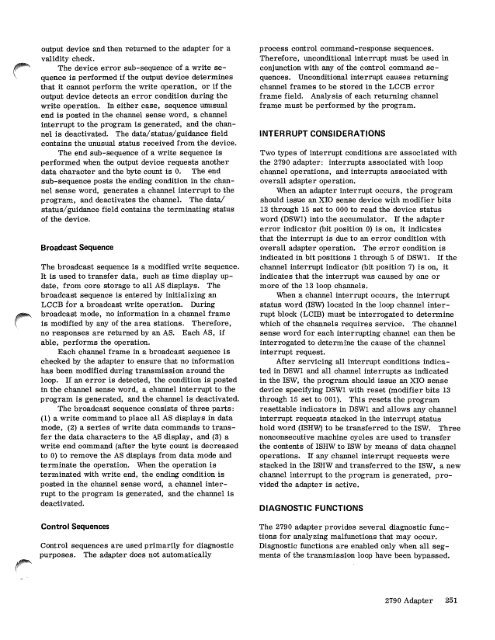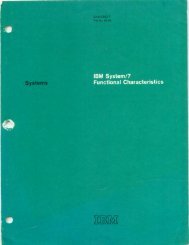Systems Reference Library - All about the IBM 1130 Computing ...
Systems Reference Library - All about the IBM 1130 Computing ...
Systems Reference Library - All about the IBM 1130 Computing ...
- No tags were found...
You also want an ePaper? Increase the reach of your titles
YUMPU automatically turns print PDFs into web optimized ePapers that Google loves.
output device and <strong>the</strong>n returned to <strong>the</strong> adapter for avalidity check.The device error sub-sequence of a write sequenceis performed if <strong>the</strong> output device determinesthat it cannot perform <strong>the</strong> write operation, or if <strong>the</strong>output device detects an error condition during <strong>the</strong>write operation. In ei<strong>the</strong>r case, sequence unusualend is posted in <strong>the</strong> channel sense word, a channelinterrupt to <strong>the</strong> program is generated, and <strong>the</strong> channelis deactivated. The data/status/guidance fieldcontains <strong>the</strong> unusual status received from <strong>the</strong> device.The end sub-sequence of a write sequence isperformed when <strong>the</strong> output device requests ano<strong>the</strong>rdata character and <strong>the</strong> byte count is 0. The endsub-sequence posts <strong>the</strong> ending condition in <strong>the</strong> channelsense word, generates a channel interrupt to <strong>the</strong>program, and deactivates <strong>the</strong> channel. The data/status/guidance field contains <strong>the</strong> terminating statusof <strong>the</strong> device.Broadcast SequenceThe broadcast sequence is a modified write sequence.It is used to transfer data, such as time display update,from core storage to all AS displays. Thebroadcast sequence is entered by initializing anLCCB for a broadcast write operation. Duringbroadcast mode, no information in a channel frameis modified by any of <strong>the</strong> area stations. Therefore,no responses are returned by an AS. Each AS, ifable, performs <strong>the</strong> operation.Each channel frame in a broadcast sequence ischecked by <strong>the</strong> adapter to ensure that no informationhas been modified during transmission around <strong>the</strong>loop. If an error is detected, <strong>the</strong> condition is postedin <strong>the</strong> channel sense word, a channel interrupt to <strong>the</strong>program is generated, and <strong>the</strong> channel is deactivated.The broadcast sequence consists of three parts:(1) a write command to place all AS displays in datamode, (2) a series of write data commands to transfer<strong>the</strong> data characters to <strong>the</strong> AS display, and (3) awrite end command (after <strong>the</strong> byte count is decreasedto 0) to remove <strong>the</strong> AS displays from data mode andterminate <strong>the</strong> operation. When <strong>the</strong> operation isterminated with write end, <strong>the</strong> ending condition isposted in <strong>the</strong> channel sense word, a channel interruptto <strong>the</strong> program is generated, and <strong>the</strong> channel isdeactivated.Control SequencesControl sequences are used primarily for diagnosticpurposes. The adapter does not automaticallyprocess control command-response sequences.Therefore, unconditional interrupt must be used inconjunction with any of <strong>the</strong> control command sequences.Unconditional interrupt causes returningchannel frames to be stored in <strong>the</strong> LCCB errorframe field. Analysis of each returning channelframe must be performed by <strong>the</strong> program.INTERRUPT CONSIDERATIONSTwo types of interrupt conditions are associated with<strong>the</strong> 2790 adapter: interrupts associated with loopchannel operations, and interrupts associated withoverall adapter operation.When an adapter interrupt occurs, <strong>the</strong> programshould issue an XIO sense device with modifier bits13 through 15 set to 000 to read <strong>the</strong> device statusword (DSW1) into <strong>the</strong> accumulator. If <strong>the</strong> adaptererror indicator (bit position 0) is on, it indicatesthat <strong>the</strong> interrupt is due to an error condition withoverall adapter operation. The error condition isindicated in bit positions 1 through 5 of DSW1. If <strong>the</strong>channel interrupt indicator (bit position 7) is on, itindicates that <strong>the</strong> interrupt was caused by one ormore of <strong>the</strong> 13 loop channels.When a channel interrupt occurs, <strong>the</strong> interruptstatus word (ISW) located in <strong>the</strong> loop channel interruptblock (LOB) must be interrogated to determinewhich of <strong>the</strong> channels requires service. The channelsense word for each interrupting channel can <strong>the</strong>n beinterrogated to determine <strong>the</strong> cause of <strong>the</strong> channelinterrupt request.After servicing all interrupt conditions indicatedin DSW1 and all channel interrupts as indicatedin <strong>the</strong> ISW, <strong>the</strong> program should issue an XIO sensedevice specifying DSW1 with reset (modifier bits 13through 15 set to 001). This resets <strong>the</strong> programresettable indicators in DSW1 and allows any channelinterrupt requests stacked in <strong>the</strong> interrupt statushold word (ISHW) to be transferred to <strong>the</strong> ISW. Threenonconsecutive machine cycles are used to transfer<strong>the</strong> contents of ISHW to ISW by means of data channeloperations. If any channel interrupt requests werestacked in <strong>the</strong> ISHW and transferred to <strong>the</strong> ISW, a newchannel interrupt to <strong>the</strong> program is generated, provided<strong>the</strong> adapter is active.DIAGNOSTIC FUNCTIONSThe 2790 adapter provides several diagnostic functionsfor analyzing malfunctions that may occur.Diagnostic functions are enabled only when all segmentsof <strong>the</strong> transmission loop have been bypassed.2790 Adapter 251
















